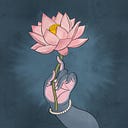Abhisārika Nāyika
This painting from the Mandi school of art depicts an abhisārika nāyika or a forward woman1, who goes out to meet her lover, from an illustration of the Rasikapriya, a text by 16th century poet Keśavadāsa. In the dead of the dark night, she is walking through a forested landscape, bedecked in an elaborate orange dress and jewelry. She seems unperturbed although there are snakes strewn across her path, and she is confronted by a female ghoul with a small child on her shoulder — an entirely frightening image, yet, when deciphered, is pregnant with symbolic meaning.
A nāyika is a heroine, used in Hindi poetry to refer to an ideal lover. Bharata’s Nāṭyaśāstra describes eight types of heroines, or aṣṭa nāyikas that feature in a nāṭaka — vāsakasajjā (one dressed up for Union), virahotkaṇṭhitā (one distressed by separation), svādhīnabhartṛkā (one having her husband in subjection), kalahāntaritā (one separated from her lover by a quarrel), khaṇḍitā (one enraged with her lover), vipralabdhā (one deceived by her lover), proṣitabhartṛka(one with a sojourning husband), and abhisārikā (one who moves to her lover).2 Keśavadāsa, in his Rasikapriya further details the nāyikas and their sub-types:
“Her beloved when the nāyika meets,
Impelled by love, or lust, or pride,
Abhisārika she is decreed;
Of this three kinds have been described-
She who with love is driven is known
Premābhisārika, and she
To whom her pride the way has shown
Is garvābhisārika indeed;
While she whom passion holds in thrall
A kāmābhisārika is called.”3
In specific, Keśavadāsa describes an example of a nāyika making haste in the dead of the night, not paying heed to the snakes entangled at her ankles, the thunderstorm in the night sky, or ghouls watching her, which fits perfectly into the elements potrayed in the painting.
“When she made haste her lover to meet
Snakes round her legs entangled were,
And many lay trampled under her feet!
And seeing her speed the demons stared
From all sides; the thick shower of rain,
She heeded not, nor the crickets’ cry,
Nor thunder of clouds: nor yet remained
Aware of ornaments falling aside,
Clothes rent, or thorns her breasts that hurt:
Seeing her the sprites said, ‘Where did you
Oh! lustful woman learn such love?
This manner of keeping your rendezvous?”4
The painting is culturally significant for many reasons, one being the antiquity of motif of the nāyika bearing the elements to meet her lover. The idea represents a remarkable cultural continuity in Indian aesthetics, the heroine having been described extensively in poetry and prose, and a favorite subject of painters across the various schools of art, not restricted to those emerging from the Punjab Hills or Pahari hill-states.
The classic example of the motif occurs in the fifth act of Śūdraka’s play The Little Clay Cart (Mṛcchakaṭika, 5th cent.), where the heroine, Vasantasenā, sets out at night in the rain to meet her lover, Cārudatta.
“Let the clouds burst into rain or thunder
or hurl down lightning bolts from above.
Neither cold nor heat can change the minds
of women setting out to meet their lovers.”
Indian art and literature are both replete with the erotic theme, often rendered through allegory. What is striking about this painting is that it is difficult to grasp the theme and the intent of the artist, and what the lady represents, without at least being mildly acquainted with the broad themes, symbolism, and methods of depiction that populate Indian art. Often, there is a certain level of cultural understanding and knowledge required to interpret themes and motifs in Indian painting. Here, the erotic nature of this painting is subtly insinuated rather than directly stated, but once alive to the semiosis of the depiction, her fervent passion is immediately palpable. Here is a brave heroine risking her life and reputation to meet her lover, not turning back despite the perils in her path. The fierceness of her ardor and determination to meet her lover harkens to the manner in which certain complex emotions and characters are conveyed through recurring, yet timeless leitmotifs.
1 Bach, Hilde. Indian Love Paintings. India: Lustre Press, 1985.
2 Bharata Muni. The Natyasastra: A Treatise on Ancient Indian Dramaturgy and Histrionics, Ascribed to Bharata Muni. India: Manisha, 1995. p 467
3 Bahadur, K.P.. Rasikapriya Of Keshavadasa. India: Motilal Banarsidass Publishers Pvt. Limited, 1990.
4 Ibid.
__________________________________________
If you find value in my work, I hope you consider becoming a patron or making a contribution via UPI to hindu.aesthetic@okicici. Hindu Aesthetic requires a lot of time and effort and your support would mean that I can continue bringing you the best possible content. ❤
